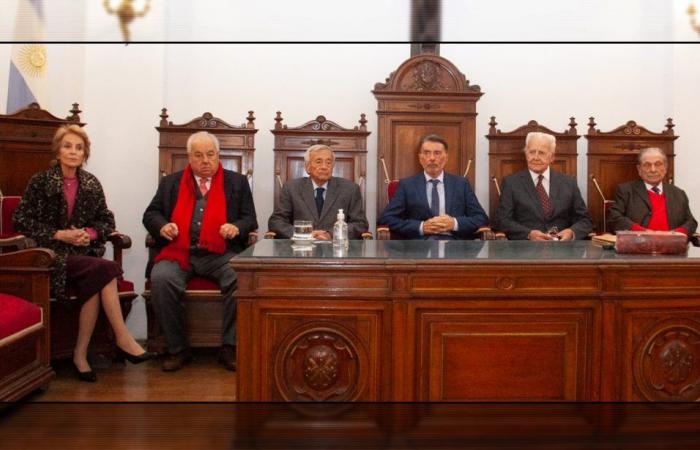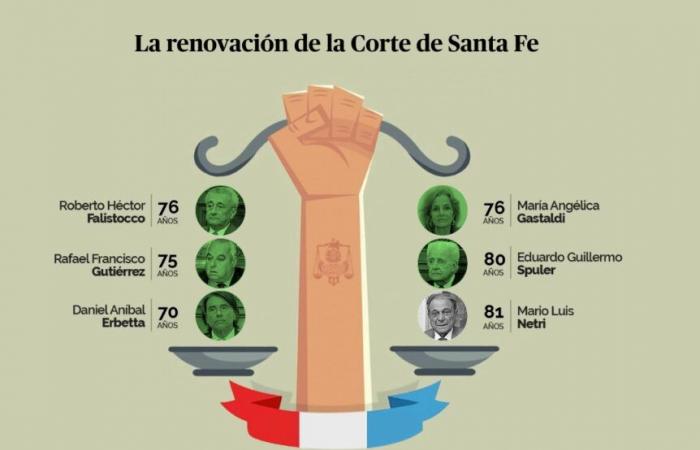For very personal reasons, Mario Netri from Rosario was the first to set a date for his retirement from the Supreme Court of Justice of Santa Fe, thus opening the door to a broader replacement that could take place in the second year of Governor Maximiliano Pullaro’s term. . Three other members of the high court have their “papers presented” and they only have to report the date of termination of their functions. The only two who did not complete this procedure are Daniel Erbetta and Roberto Falistocco, who aim to continue in the role.
Although it should not be surprising that at the age of 81 and after 62 years of activity in the Judiciary a judge of the Court retires, the extension of the functions with no end in sight for the courtiers had been a cause of controversy within the provincial government. Netri was appointed to the Court 23 years ago on the recommendation of Horacio Usandizaga, although his application was sent by Carlos Reutemann.
“The message is being understood,” was heard in the Gray House after Netri’s announcement. Since the beginning of its administration, the Unidos government has promoted a renewal of the Court within the framework of other changes it proposes for the Santa Fe justice system. “It is expensive and does not provide a response,” the governor said in his May 1 speech at the Legislature.
From day one, the current government made known its intentions to undertake a renewal of the majority of the six members of the current Court. And as much as possible do it with good manners, without having to resort to formal requests or unkind intimations. That is why this first step by Netri was celebrated, which will enable another discussion that was incipient: that of replacement candidates.
If the path inaugurated by Netri, who formally announced that he will leave on November 1, is followed by other members of the high court, the government will have managed to carry out one of the most difficult changes that is proposed with a couple of feints and without having to appeal to second strategies.
As reinforcement of his intention to change, he added another debate that now begins with the discussion of changes to the province’s pension system, which could alter some of the favorable conditions that contributors to the Judicial Branch have.
If it is agreed, for example, to put a lower limit than the current one on future retirement benefits in the province, it will be a detail that will accelerate withdrawal requests. Some of this has already begun to happen at other levels of justice, where judges with many years of seniority began to process their retirement. Some in advance and others after being past years.
In the Courts this does not go down well at all, because it adds to the vacancies that have been claimed, to which they must now add the specifications of those who will occupy the new empty offices.
The government promised to look closely at the judicial map before appointing judges when it is not entirely clear that they are absolutely necessary. They cite as a bad example what happens in the jurisdiction of Reconquista and Vera, where there are only eight prosecutors – they maintain that there should be 12 or 14 – and 9 judges, when those who understand judicial functioning assure that three is enough.
In Court, Netri set a date for his termination before the end of the year, leaving four months for the government to manage his replacement, a time that is typical for replacements in this hierarchy. In the meantime, he must resolve the pending issues and ask that no new files be added. This weekend he participated in Buenos Aires at the Federal Board of Cortes, a meeting that takes place every month. Another alternative would be not to replace it and for there to once again be an odd Court, with only five members.
His decision can serve the government to show a model of how things can be done through the front door. If there was a voluntary retirement plan, the one who could follow the steps would be Eduardo Spuler from Santa Fe, who is also over 80 years old and just in case he has already completed the corresponding retirement form. More difficult may be the replacement of the current president and the one who held that position the most times (13 times this year), Rafael Gutiérrez from Santa Fe, who although he completed the papers, aspired to a political negotiation more than a conversation about when to retire. .
María Angélica Gastaldi also has the process completed, but not now, but rather she completed it during the years of the Covid pandemic and for reasons that exceed the question of age and the reasons for this present with a new government. But she completes with her name the list of four who could be invited to speak about the “new institutional functioning” that the government wants for the Court. Some of these calls have already been issued.
If Gastaldi continued in office, in 2025 it would be his responsibility to preside over the Provincial Court, according to the rotation agreement respected by the courtiers. She is the only woman on the court, and the first in the history of Santa Fe, so it would be rude to insist on her situation before dealing with the rest of the cases.
Daniel Erbetta, although he exceeds the retirement age established by the Constitution of Santa Fe, is the only one who is still below the limit of 75 years claimed by the National Constitution. Furthermore, he is assisted by an argument that is not taken into account if they wanted to include him on the list: it is doubtful that he is, as the Santa Fe Magna Carta says, “in a position to retire”, having contributed to other funds before entering the Court. . He would lack years of contribution.
Roberto Falistocco is currently the oldest member of the Court and by age is included among those who could be invited to replace him. He did not complete the paperwork and has no intention of retiring. But we will have to see.
The government insists that the replacement of the Santa Fe Court is a process that “cannot be stopped.” It is likely that in the next official speeches references to the need to “modernize justice” will be repeated, and issues inherent to the Judiciary will also be included in the chapter on efficient use of resources.
What will the next steps be like? The government reaffirms that it has firm ideas to manage, and among them is the replacement in the Court, and at the same time claims that it wants to be respectful of the institutions. “Firm and respectful,” they repeat like a mandate.
Within the Court, the idea is gaining ground that “the gales cannot be stopped with one hand.” It’s a matter of time.





